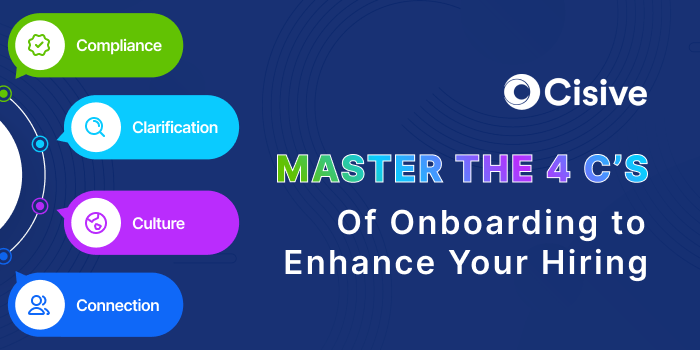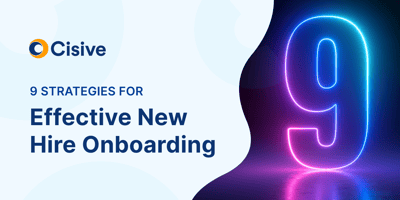

Regardless of the quality of your product or your brand’s reputation, your hiring strategy may be...

The 4 C’s of onboarding help companies minimize costs associated with new hire training by increasing productivity and improving retention. The four C's are compliance, clarification, culture, and connection.
The onboarding process is an important part of any company's long-term success. This is partly because turnover is costly, both financially and in terms of productivity.
Dr. Talya Bauer, Ph.D., from the Society for Human Resource Management (SHRM) examined the components of successful onboarding processes and concluded that they were comprised of four core elements, coined the "4 C's." Companies that applied the 4 C's saw new employees have faster adjustments, better attitudes, greater productivity, and increased retention.
Key TakeawaysHere are important reasons to include the 4 C's in the onboarding process:
|
The 4 C's of onboarding are compliance, clarification, culture, and connection.
Compliance can be summed up with the three P's: policies, procedures, and paperwork. This is where a new employee learns about rules and regulations and fills out legal documents required by federal, state, and local entities.
This process can also include providing a timecard or badge, setting up a workstation, and anything else the new employee needs to get started. Most companies have this part of the 4 C's covered.
Clarification involves informing new employees what they need to know about what's expected of them about their job duties. This is the clarification of what their role is within the company.
This step can also include other details, such as clarifying who they report to, how to dress, and where to park. Many companies also have this "C" covered.
While culture can be thought of as your company's values or mission statement, it can also be much more practical. For example, giving a new hire a tour, explaining how the company functions, and going over norms are ways to introduce the new hire to the company culture.
Culture answers the question "Why?" and helps the new hire understand the culture that's been established so they're better able to fit into it. This is one of the 4 C's that many companies fail to implement.
Connection is one of the most important aspects of onboarding and the one most companies fail to implement meaningfully. Connection helps new hires integrate into the culture more readily and helps teams operate more effectively.
Connection is often achieved through team-building exercises, icebreakers, and networking. Many companies make the mistake of onboarding new hires in isolation from the rest of their team, thinking this can allow the team to focus on their work without interruptions and distractions.
However, providing an early opportunity for connection for new hires has a longer-lasting impact on productivity than preventing interruptions.
If you think of the four C's as a structure like a pyramid, compliance and clarification are the foundation that supports the other two core elements. While foundational elements are important in their own right, they don't reach the heights of success on their own.
With the proper foundation of compliance and clarification, culture and connection can bring about the desired results companies wish to see in the onboarding process, namely greater productivity and a higher retention rate. No single core element can achieve the results that all four C's reach in combination.
A proper onboarding process saves the company money by reducing the cost of hiring the replacements of dissatisfied recruits who end up leaving. It also makes those who stay more productive. Here are the key benefits to understand about the 4 C's of onboarding:
New hires who experience onboarding through the 4 C's have a higher job satisfaction rate. New employees who start with a full understanding of their job duties and know what's expected of them may feel more confident and experience more enjoyment of their work.
Understanding culture helps new employees feel more like part of the company, rather than feeling left out. This leads to connection, which brings about job satisfaction because new hires feel that they're part of a team and that they belong.
New employees who receive proper onboarding with the 4 C's are productive more quickly than those who don't. Rather than having to spend time figuring out something basic, such as where they can find a stapler, they have everything they need when they start.
Also, new hires who have had proper onboarding are more engaged, and engaged employees are more productive. The four C's create the foundation for an engaged, productive employee.
The cost of replacing an employee can range from one-half to two times their annual salary. When the replacement employee then also needs to be replaced, the costs can snowball.
The 4 C's of onboarding help reduce turnover and increase retention. Employees with clear job descriptions and training are integrated into the culture more quickly, feel like part of the team sooner, and are more likely to stay with the company.
Here are the most common ways companies apply the 4 C's of onboarding.
1. One-on-one Onboarding
The 4 C's still have applications for small companies with fewer than 10 employees. In this case, the 4 C's are applied verbally, other than the initial required paperwork.
The manager or company owner can share the job description, company culture, and introductions to team members.
Handbook Onboarding
For small and medium companies with multiple departments, including one that functions as human resources, a new hire handbook can convey the 4 C's. Each new hire can receive standardized instructions that include company policies and information about company culture.
Each department can also provide detailed written instructions for the various positions so new hires have all the information they need at their fingertips from day one.
Web-based Onboarding
For larger companies with high volume hiring, those that have high turnover, or any sized company that wants to automate and streamline the onboarding process, web-based solutions are the most efficient.
Automated emails can include information to access an onboarding portal. Paperwork and initial information the new hire needs can be set up right on the portal.
Applying the 4 C's has challenges, such as resources, consistency, and efficiency.
Onboarding can be time-consuming, taking up the new hire's time and other employees' time. Some companies even have employees dedicated to the onboarding process.
Consistency is important to ensure that each new employee is treated the same and receives identical information. This can be challenging for companies that operate with high-volume hiring or don't have the resources to maintain dedicated onboarding personnel.
Some companies struggle to find the balance between resource limitations and the proper allocation of time needed to effectively apply the 4 C's. An inefficient process can leave onboarding staff overwhelmed and new hires feeling the stress and frustration of an inefficient system.
Many companies don't want to implement robust onboarding programs because of the resources a model such as the 4 C's involves. However, they then end up paying more in lower productivity and replacement costs for the employees they lose to ineffective onboarding.
Implementing the 4 C's of onboarding into your new hire process is worth the effort because it can make a difference in productivity and retention. However, many parts of the 4 C's process can be automated and streamlined so it doesn't take up a significant amount of time and numerous resources.
Find out how Cisive's HCM technology can integrate a web-based solution into your onboarding process, allowing you to integrate the 4 C's in an efficient, automated way. Our web-based portal can contain everything your new employees need, from tax forms to training videos.
Much of the 4 C's can be automated on the portal with new hire training videos, including a virtual tour of the company, so every new employee receives the same information from day one, consistently and reliably.
Find out more about how Cisive's powerful technology can help your company implement the 4 C's of onboarding into an effective new hire process. Speak to an expert today.

Regardless of the quality of your product or your brand’s reputation, your hiring strategy may be...

In today's hiring market, the importance of background screening solutions cannot be overstated....

New hire onboarding is critical to helping your new employees integrate into the company. To make...